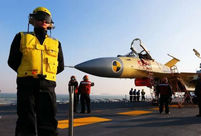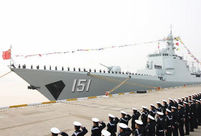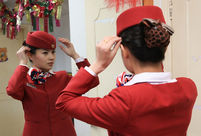 Famous Lanzhou beef noodles
Famous Lanzhou beef noodles Armed Police hold anti-terrorism drill in SE China's Xiamen
Armed Police hold anti-terrorism drill in SE China's Xiamen Harbin Int'l Ice and Snow Festival opens
Harbin Int'l Ice and Snow Festival opens 'Jin' named the word of the year by cross-strait netizens
'Jin' named the word of the year by cross-strait netizens Chinese scientific expedition goes to build new Antarctica station
Chinese scientific expedition goes to build new Antarctica station
 Chinese naval escort fleet conducts replenishment in Indian Ocean
Chinese naval escort fleet conducts replenishment in Indian Ocean 17th joint patrol of Mekong River to start
17th joint patrol of Mekong River to start China's moon rover, lander photograph each other
China's moon rover, lander photograph each otherBEIJING, Jan. 9 -- The year 2013 for China's civil aviation industry was characterized by increasing global integration, and hopes are high that more such international cooperation can cement the sector's emergence on the world stage this year.
Asked how the Aviation Industry Corporation (AVIC) performed over the past 12 months, Chen Guanjun, vice president of international business for China's top aircraft manufacturer, beamed.
"Marvelously."
To justify his satisfaction, he cited high-profile presences at international air shows, the volume of sub-contracted production topping 1 billion U.S. dollars, and the launch of the Modern Ark 700 China-developed aircraft project to create the world's best regional turboprop plane.
Three decades ago, China didn't figure in the international civil aviation scene, with barely any civil aircraft infrastructure. But today, it is an indispensable member of the global industry.
On Wednesday, the chairman of French aircraft engine giant Safran visited the AVIC to discuss further cooperation. Safran is just one of many foreign aviation firms that have taken a serious look at business opportunities in China.
Boeing and Airbus have equipped almost all their civil aircraft with components made in China, while Chinese-made aircraft have been exported to 40 countries.
The aviation industry involves high risks, big investments and long development periods, said Chen. "That is to say, making planes behind closed doors cannot realize healthy or sustainable development. Instead, integrating with the world is inevitable."
Integration, however, has been difficult. China was long treated as little more than a manufacturer of labor-intensive products. Due to its technological backwardness and ideological differences, the country was ignored by Western aviation giants.
Now, however, these major players cannot produce aircraft without China's contribution.
Airbus, for example, has cooperated with Chinese companies in all aspects from design to production and assembly.
More importantly, China produces the entire wing of the A320. Rafael Gonzalez-Ripoll, CEO of Airbus China, said that China is the second country after Britain to be capable of this task.
Cooperation in sub-contracted production also puts many Chinese manufacturers on the lists of global providers to international giants. Some have even become leading or exclusive suppliers.
The fast-growing Chinese domestic market is generally credited with driving this transformation. According to the Shanghai-based Commercial Aircraft Corporation, the number of passenger aircraft in China will rise from 1,969 in 2012 to 6,494 in 2032, accounting for 17 percent of the global total. Chinese enterprises and individuals are expected to purchase 5,357 aircraft with at least 50 seats, worth 647 billion U.S. dollars, in that period.
Six years ago, Airbus forecast China would be the second-largest civil aviation market after the United States by 2025.
China's Ministry of Industry and Information Technology last year issued a medium and long-term development plan for the civil aviation sector, encouraging Chinese firms to engage more in global cooperation while welcoming foreign providers in domestic programs.
Since 2009, a series of high-level commercial interactions, including mergers and acquisitions, has helped China grow from "cheap aircraft manufacturer to important business partner," noted Chen.
In 2010, the AVIC began working with Canada's Bombardier to design, manufacture and sell aircraft together. In 2011, the AVIC formed a partnership with GE to build an avionics company. To support development of the C919, China's largest domestically manufactured aircraft, the AVIC has partnered with almost all international aircraft manufacturers.
Exports of China-developed aircraft have helped China broaden connections with the world, but until recently the long-term challenge was getting China-made aircraft flying abroad.
The MA60 was the first regional turboprop made in China in line with international airworthiness criteria. But these models, first produced in 2000, stood on the parking apron for years before exports began in 2005.
Since then, international demand for MA aircraft has boomed, with 90 deliveries and 200 orders involving 200 airlines in 15 countries.
"Our core competence is developing customized quality products at competitive costs," Chen explained. "That is the key to achieving success in developing markets in Asia, Africa and Latin America."
In recent years, it was hard to imagine China would export aircraft, said Wang Yue, vice president of A. BRAIN, a leading manufacturing consultancy. "Today, though. Chinese-made aircraft are shouldering a large volume of traffic in many countries, having been universally recognized."
At the end of last century, it was estimated that the techonology level of China's civil aircraft manufacturers lagged about 20 years behind that of Western counterparts, but this is steadily narrowing.
Civil aviation in the country is getting stronger with integration into the global chain. In 2013, the AVIC ranked number 212 in the Fortune 500 list.
Despite significant gaps remaining, China is gaining confidence. Chen believed China, which is still subject to some Western technology embargoes, has learned to play with a global mindset, with more respect for intellectual property rules, "to take its place in the global aviation industry."
 Chinese Consulate General in S.F. burned for arson attack
Chinese Consulate General in S.F. burned for arson attack Roar of J-15 fighter is melody for operator on the Liaoning
Roar of J-15 fighter is melody for operator on the Liaoning A 90-year-old forester's four decades
A 90-year-old forester's four decades Most touching moments in 2013
Most touching moments in 2013 2013: Joys and sorrows of world politicians
2013: Joys and sorrows of world politicians Missile destroyer Zhengzhou commissioned to Chinese navy
Missile destroyer Zhengzhou commissioned to Chinese navy China is technically ready to explore Mars
China is technically ready to explore Mars Photo story: Life changed by mobile technology
Photo story: Life changed by mobile technology Bullet train attendants' Christmas Eve
Bullet train attendants' Christmas Eve Heart-warming Laba porridge
Heart-warming Laba porridge Gallery: China's trapped icebreaker makes successful escape
Gallery: China's trapped icebreaker makes successful escape Photo story: We are special soldiers
Photo story: We are special soldiers 'Rong' selected HK's character of the year for 2014
'Rong' selected HK's character of the year for 2014 Famous Lanzhou beef noodles
Famous Lanzhou beef noodles Chinese Consulate Arson Suspect Makes 1st Court Appearance
Chinese Consulate Arson Suspect Makes 1st Court AppearanceDay|Week|Month